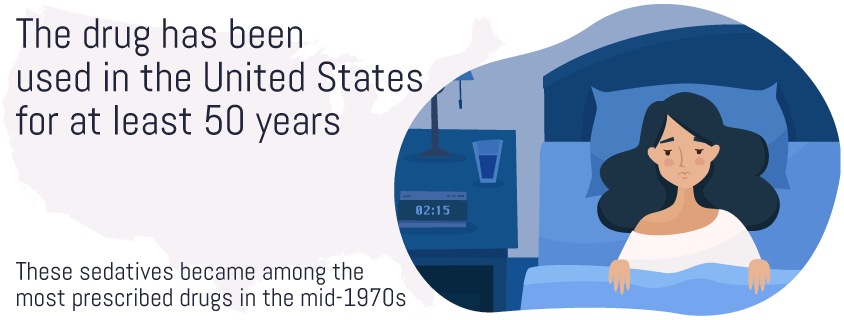SUBSTANCE ABUSE
Benzodiazepine
Sedatives have been in use for a long time in the United States and across the world. Mostly, these are substances that would reduce excitement and irritability and thus induce sedation. They would depress the nervous system, and this would result in the decelerated functioning of this system.
Benzodiazepines work by causing depression of nerves in the central nervous system. In particular, these drugs would enhance the effects of GABA that is found within the brain (Ogbru, 2019). Primarily, this a neurotransmitter that reduces the activity of brain nerves when it binds with benzodiazepines. In essence, GABA-benzodiazepines binding would lower the activity of the brain and thus bringing calmness to people with anxiety and seizures.
Several types of sedatives have been prescribed in hospitals to manage various situations of the patients. However, some of these sedatives have been abused and have, consequently, resulted in addiction among the users. In particular, benzodiazepine has been a regular sedative that is commonly prescribed in healthcare organizations (Ogbru, 2019).
Statistics on Use and Misuse
About 12.5% of people in the United States use benzodiazepines (NIDA, 2018). Mainly, this stands for about 30.5 million individuals in the country (NIDA, 2018). The population of adults who receive benzodiazepine prescription increased to 5.6% in 2013 from 4.1% in 1996 (W-BAD, 2019).
Approximately 46.3% of those people who abuse this drug do it to relieve tension, and 22.4 % do it for sleep reasons (NIDA, 2018). The remaining 11.8% do it to get high, and 5.7% engage in the misuse of experimentation (NIDA, 2018).
Most people obtain these drugs from relatives and friends, and only about 20% receive them from doctors (NIDA, 2018).
PRESCRIPTION SEDATIVE MEDICATION
History
The use of sedative-hypnotic drugs has a long history. Mostly, the abuse and use of these drugs increased after the Second World War, and it later peaked about two decades later. By 2013, nearly nine million people in the U.S. were reported to use prescription drugs that would assist them to sleep (Kaufmann et al., 2016). The drugs have beneficial effects and ease the anxiety associated with anxiety-provoking and painful procedures. Usually, sedatives are substances whose use is controlled because of the likelihood of abuse and misuse them. By themselves, the sedative will not relieve pain in patients, but could be used to prepare patients for procedures like surgery, and others.
The history of use of sedatives has revealed several issues about them. The use of sedatives could make people develop sedative dependence. In essence, this is a situation where the people who are used to taking these sedatives would have to use them so that they can function normally. It is, however, possible to treat dependence through particular therapies.
Additionally, the exploration of the history of prescription sedatives reveals that these medications would be misused by people. People would use sedatives for non-medical or recreational use. Individuals with sleeplessness, anxiety, and stress would occasionally decide to use sedatives to ease their problems (Ogbru, 2019). Most of the people who misuse these drugs usually have been prescribed legitimately, but choose to take an overdose of the sedative or use it alongside drugs or substances like alcohol.
Side Effects
The use or abuse of benzodiazepines has several effects on the users. Usually, people would have different reactions towards these drugs, and this would mean one may not experience all the side effects. Length of addiction or usage of these sedatives would, to some extent, dictate the impact that a person would experience. The following are some of the side effects that one would experience after taking benzodiazepines.
Dizziness is one of the side effects of these drugs. Individuals who take benzodiazepines are likely to feel drowsy (Ogbru, 2019). When doses are high, the level of dizziness becomes more pronounced. It is because of the effects that these drugs have on the central nervous system.
If the worst case scenarios, vertigo would develop in the users of the medications. Additionally, a person could experience fainting cycles. Primarily, to manage the fainting spells, it would be necessary to take the correct doses as prescribed by the doctor.
Impaired cognition is another side effect of the medications. Sedatives would have the potential to impact the cognition of an individual. Benzodiazepines would impair various elements of cognition. Verbal learning, speed of processing, and others are some of the domains of cognition that these drugs affect.
Impaired judgment is also a side effect of these sedatives. The effects of the drugs on the brain could have considerable effects. The confusion and impaired decisions would have an impact on the thinking and the ability to make choices. Impaired judgment would result in a person.
Benzodiazepines
The commonly used medication in treating sleep and related disorders is benzodiazepines. It is sedative-hypnotic and would be used on patients to promote sleeping in them. The drug has been used in the United States for at least 50 years (Wick, 2013). In essence, this has made it possible for the healthcare system of the country to develop a love-hate relationship with benzodiazepines. The first benzodiazepine was identified in 1955 by Leo Sternbach, who was a Hoffmann-La Roche chemist at the time (Wick, 2013). It was chlordiazepoxide (Librium), and in the following years, it was sold and marketed as Librium. The search for more of benzodiazepines continued, and Roche produced Valium (diazepam) in 1963 (Wick, 2013). The competitors of the company started researching for possible analogs.
In the beginning, benzodiazepine seemed less toxic, and people did not think that they could lead to dependence. Unlike other sedatives, they did not cause respiratory depression. It is some of these advantages that made the popularity of benzodiazepines increase and their patient demand to go high. In the mid-1970s, these sedatives became among the most prescribed drugs among the patients (Wick, 2013). However, at the time, research was ongoing on these drugs, and soon, it was possible to establish the mechanism of action of these drugs. They affected gamma-aminobutyric acid to induce their effects.
In the coming years, the propensity and enthusiasm that the clinicians had on benzodiazepines started to fade. They had a new concern that they had to consider during the prescription of these sedatives. They needed to consider dependence issues and the possibility of abuse of the drug. The information about benzodiazepines was quickly accumulating, and legislators and medical leaders started to take actions that would control the use of these drugs. Legislations and guidelines directing their use were developed. At the same time, clinicians started to elicit concerns about the use of benzodiazepines by old patients as the medications had reduced therapeutic responses. The knowledge of the side effects of these sedatives also increased, and there was a need to address the situation. To date, the story of benzodiazepines continues to change as new information on these medications would be found occasionally.
Benzodiazepine Uses
Most patients would experience various mental and conditions that should be addressed by medical practitioners. Benzodiazepines assist in the treatment of different neurological and psychological disorders in people. Mainly, this is because these drugs have an impact on neurons that induce anxiety and stress reactions. Thus, they can ease the symptoms of such disorders and improve the wellness of people. The following are some of the health issues that benzodiazepines could assist to resolve.
Alcohol Withdrawal
At a time when alcohol dependence is a pervasive and increasing problem, it is necessary to adopt measures that would assist in alcohol withdrawal. Usually, during alcohol withdrawal, a person would show various symptoms, and they would vary from mild symptoms to serious ones.
The use of benzodiazepines could help in the management of these symptoms (Ogbru, 2019). In fact, it is commonly prescribed a sedative for this condition. It would reduce the occurrence of severe symptoms when an individual is undergoing alcohol withdrawal, and also assist in removing toxins from alcohol-dependent people.
Anxiety
Anxiety is a common psychological condition that would happen naturally to people. However, some individuals could experience this emotion more than others. Usually, it causes fear, alertness, and could also lead to an increased heart rate. In situations where the anxiety seems abnormally high, it could be essential to seek medication attention. When patients have panic attacks, it is necessary that health care professionals are sought to address the situation. The medical professionals could prescribe benzodiazepines for the patient.
About 56% of benzodiazepine prescriptions are done for anxiety reasons (W-BAD, 2019). Primarily, these sedatives have a fast-acting anti-anxiety impact and are essential to treating anxiety in patients. However, some researchers do not consider this as a suitable long-term therapy for panic disorder. Other treatments could be more appropriate compared to benzodiazepines since these have their side effects.
Seizures
Some patients could develop seizures when they are sick. Usually, these are electrical disturbances that happen in the brain, and they are uncontrollable and occur suddenly. They would affect an individual’s consciousness level, feelings, movements, and behavior. Thus, it is necessary to provide medications that would assist in lessening some of these symptoms in the patient.
Usually, benzodiazepines act as strong anticonvulsants, and they would be able to offer effective prevention of epileptic seizures. When the patients have seizures, the doctor always has the option to use these drugs to improve the situation.
Muscle Relaxation
Muscle relaxation is used to realize different effects in patients. In some cases, the intention may be to control insomnia, anxiety, and stress. In other situations, it could assist in lowering chronic pain in patients. Thus, administration of a medication that could assist in achieving muscle relaxation is a considerable therapeutic step.
Benzodiazepine is a sedative that has a muscle relaxant effect on the patient. The drug assists in lowering muscle spasm and also ensures that the muscle tone in the body is appropriate. In this way, it is possible to improve the patient situation.
Anesthesia
During treatment, it is sometimes necessary to give medications to the patients that would allow particular procedures to be done without pain. In other situations, it would be crucial that the patient is unaware of the procedures being done unto them.
Benzodiazepine is one of those drugs that could be used for anesthesia (Ogbru, 2019). The medical professionals could use benzodiazepines after surgery or before surgery to maintain or induce anesthesia. The drug will eliminate the pain from the patients. However, not all types of benzodiazepines could be used for this purpose in healthcare settings.
Insomnia
Some people would experience difficulties regarding falling asleep. In other situations, they would remain asleep for longer periods than necessary. When the condition is severe, it may be necessary that someone seeks medical assistance. The doctor would prescribe benzodiazepines that could induce sleep in people with insomnia (Ogbru, 2019).
Usually, these medications would bind to the GABA receptors, and this would result in promoting sleep in a person. Mainly, to avoid addiction and dependence on these drugs, it would be necessary to use these medications as prescribed by the doctor. Overdose and abuse of the same should be avoided.
Withdrawal Symptoms
Stopping to use benzodiazepines comes with various effects (Ogbru, 2019). The symptoms would depend on the level of addiction. For those who had taken the sedatives for an extended period, it is possible for the withdrawal symptoms to stay for months. Thus, withdrawal should be done procedurally and with care to minimize and manage these symptoms. The following are among some of the withdrawal symptoms of benzodiazepines.
Headaches consist of the first set of symptoms that a person would experience after withdrawing from benzodiazepines use. The period that the person will experience this symptom will depend on how long the individual has been using these drugs.
Additionally, a person could have stomach pain after withdrawal. In essence, this would be accompanied by nausea that starts when consumption of the drug stops.
Furthermore, tremors also form an essential withdrawal symptom for benzodiazepines. At other times, the patient could experience sweating. Hallucinations and dizziness could also happen to the person.
General body fatigue is another notable symptom that one would experience. The symptoms that the drugs meant to control come bouncing back when the withdrawal happens. They include confusion, anxiety, and mental states like depression.
Seizures would also be witnessed in some people, and others would have suicidal thoughts. All these symptoms are unique to a person, and it is hard for a single person to experience all of them.
TYPES OF BENZODIAZEPINES
There are several types of benzodiazepines that patients or individuals could use as sedatives (Levels, 2016). The onset of actions by these types is different, with some being slow, others moderate, and others would act quickly. The choice of the kind that would be used on a person would depend on the symptoms of the patients, the type of wanted sedation, and how quick the sedation is wanted. They exist in different formulations. Some could be given as an injection, rectal gel, capsule, oral liquid, or tablets.
The action time for all these types could be different. Also, the duration in which these drugs are active when they are in the body could be different. In essence, it would vary from one type to the other.
EXAMPLES OF BENZODIAZEPINES INCLUDE:
Diazepam (Valium)
Lorazepam (Ativan)
Alprazolam (Xanax)
Clonazepam (Klonopin)
Clorazepate (Tranxene)
Midazolam (Versed)
Triazolam (Halcion)
Estazolam (Prosom) (Ogbru, 2019)
Temazepam (Restoril)
Chlordiazepoxide (Librium)
Flurazepam (Dalmane)
SUBSTANCE ABUSE
Benzodiazepines Long-Term Effects
Usually, health care professionals would prescribe benzodiazepines for short-term use since they can alter the functioning of the brain. However, when one develops dependence of this drug, it would have several long-term effects on the body (Baldwin et al., 2014). Addiction is one of the long-term effects of this drug. Importantly, the patient could develop cognitive decline due to changed brain function. The cases of confusion increase in the patient when the person uses this drug for a long time.
Sleep and Mood Disturbances
Benzodiazepines could worsen the sleep issue when used for a long time. Usually, they affect sleep architecture and thus resulting in inconsistent sleep patterns. They could lead to decreased sleep or increased sleep time. They could also affect the sleep mood and energy.
Additionally, benzodiazepines could cause physical and mental health. It could lead to psychological conditions such as psychosis, PTSD, anxiety, and depression. The users could also experience sexual dysfunction problems.
Suicidal Ideation
Self-harm and suicide is also an effect of long-term use of these drugs. Usually, the side effects of benzodiazepines would cause a psychiatric disturbance in a person. Again, the drug has some effects on the functioning of the brain. In essence, these factors and others would make the person to develop suicidal thoughts (Baldwin et al., 2014).
Studies have indicated that people who are addicted to this drug have higher chances to engage in self-harm activities compared to other people. Additionally, the users of this drug could engage in suicide during the withdrawal phase. Therefore, it would be necessary that the withdrawal is done a way that is procedural and one that will lower the possibility of suicidal thoughts.
Benzodiazepine Detox
It is possible to carry out a detoxification process for a person who is addicted to benzodiazepines. In essence, it is the initial step in the treatment of benzodiazepine addiction. The process assists in removing the drug from the body of an individual (El-Gharbawy et al., 2015). It is essential that the detox procedure is carried out properly since it could result in severe side effects if not carried out correctly.
The fatal symptoms such as suicidal behavior and seizures should be monitored during the detox procedure. When the detox is medically supervised, it makes the entire process safe and also lowers the cases of relapse. For benzodiazepines, the detox procedure could stay for many months based on the duration of use and the type of drug taken.
Resources
Resources
- Baldwin, D. S., Aitchison, K., Bateson, A., Curran, H. V., Davies, S., Leonard, B., … & Wilson, S. (2014). Benzodiazepines: Risks and benefits. A reconsideration. Focus, 12(2), 229-234.
- El-Gharbawy, D. M., Ramadan, E. S., El-Mehallawi, I. H., Draz, E. I., & Maklad, A. I. (2015). Detoxification methods of benzodiazepines mono-dependence: application and comparison. Mansoura Journal of Forensic Medicine and Clinical Toxicology, 23 (1).
- Kaufmann, C. N., Spira, A. P., Alexander, G. C., Rutkow, L., & Mojtabai, R. (2016). Trends in prescribing of sedative‐hypnotic medications in the USA: 1993–2010. Pharmacoepidemiology and drug safety, 25(6), 637-645.
- Levels, C. (2016). Benzodiazepines. Retrieved from http://2tlwk93pj6ddba08a1egtidy.wpengine.netdna-cdn.com/wp-content/uploads/2017/09/final_info_benzodiazepines_sheet_ext_001.01_07262016_mmedits.pdf
- NIDA. (2018). Research suggests benzodiazepine use is high while use disorder rates are low. Retrieved on 7 June 2019, from https://www.drugabuse.gov/news-events/latest-science/research-suggests-benzodiazepine-use-high-while-use-disorder-rates-are-low
- Ogbru, A. (2019). Benzodiazepines. Retrieved on 7 June 2019, from https://www.rxlist.com/benzodiazepines/drugs-condition.htm
- W-BAD. (2019). Statistics. Retrieved on 7 June 2019, from https://w-bad.org/statistics/
Wick, J. (2013). The history of benzodiazepines. The Consultant Pharmacist®, 28(9), 538-548.
SAFE HARBOR TREATMENT CENTER
Finding Help with Benzodiazepines
It is possible to carry out a detoxification process for a person who is addicted to benzodiazepines. In essence, it is the initial step in the treatment of benzodiazepine addiction. The process assists in removing the drug from the body of an individual (El-Gharbawy et al., 2015). It is essential that the detox procedure is carried out properly since it could result in severe side effects if not carried out correctly. The fatal symptoms such as suicidal behavior and seizures should be monitored during the detox procedure. When the detox is medically supervised, it makes the entire process safe and also lowers the cases of relapse. For benzodiazepines, the detox procedure could stay for many months based on the duration of use and the type of drug taken.




